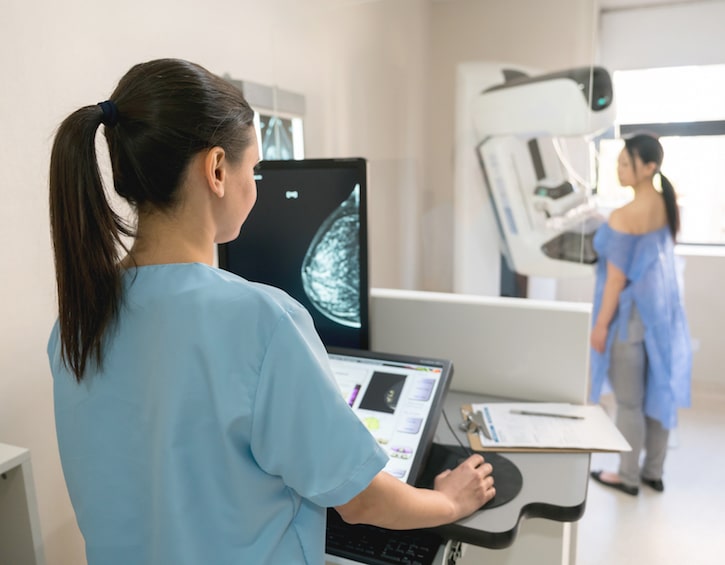
Have you had your first mammogram yet? We discuss the importance of mammograms for early breast cancer detection, where to get a mammogram and answer FAQs on this screening
Breast cancer is the number one killer cancer among women in Singapore. 1 in 13 women are diagnosed with breast cancer every year, six women are diagnosed with breast cancer every day and one death occurs from breast cancer daily.* However, it’s not all doom and gloom. Early detection of breast cancer, largely through mammograms, has been shown to save lives. If you are watching out for any early signs of cancer by doing a monthly breast self-examination you may be wondering what the next step is and when to go for that first mammogram. So we chat all about mammograms with Dr Rameysh Danovani, Consultant Radiologist and the Medical Director of Specialist Women’s Imaging.
When should women start having a mammogram?
Currently, Singapore’s national screening guidelines recommend screening mammograms for women from age 50-59 years old, which is the practice in many countries too. Nevertheless, women from the age of 40 can have the opportunity to consider screening mammograms and to discuss with their physicians on their risks of breast cancer and the potential benefits of screening. This is particularly in light of the apparent rising trend in the incidence of breast cancer in patients younger than 50 years old. In addition, a recent study published earlier in the year has reported reduced mortality with mammography screening for women from the age of 40.
If you have no lumps or signs of early breast cancer, do you still need to have mammograms?
Indeed this forms the basis of screening mammograms, so that cancers are detected early while they are still small and at an early stage. When detected early, there is a better chance of survival when compared to a large tumour that can already be felt or even be visible. Large cancers or delayed cancer diagnoses carry the risk of widespread metastasis to the rest of the body as the cancer advances.
Read more: Early Signs and symptoms of breast cancer

Are mammograms harmful?
According to the Singapore Cancer Society, no, this is a misconception. “A common perception is that mammograms are harmful to the body and may increase the existing risk of cancer as they expose women to radiation during the screening process. However, in actuality, radiation exposure during mammograms is very low. Correspondingly, the health risk to women is also very low.”
What are 3D and 2D mammograms, and what are the pros and cons of each?
A 3D mammogram (or tomosynthesis) acquires multiple images of the breast in a single sitting, thereby providing much needed information which would otherwise be missing or inadequate in a standard 2D mammogram, where only a single image is produced. With the latest technology, tomosynthesis can be acquired along with the standard 2D mammograms in a single sitting, as fast as 4 seconds, without the need for additional sessions, breast compression or other procedures. It may be of a slightly higher cost, but it has been shown to have better cancer detection rates than standard 2D mammograms alone, which has been reported in numerous global studies. For patients who are attending screening mammograms for the first time, and for those patients who are known to have high breast density from prior mammograms, it would be recommended to include tomosynthesis in their choice of mammography examination.

Are mammograms effective on all breast sizes?
From the diagnostic perspective, any breast size can be imaged by mammography. However, from the perspective of patients’ comfort, there are inconclusive suggestions that women at either end of the range of breast sizes (i.e the very small and the very large) experience more discomfort. Latest developments in mammography equipment have included compression paddles with a curved contour, designed to address this particular issue. Preliminary findings have shown improved patients’ experience with its use.
Are mammograms painful?
Reports of pain or discomfort from mammograms vary widely in the population, with many patients experiencing little or no discomfort, while some do experience significant discomfort or even pain. It is important to communicate what you are experiencing with the radiographer so that levels of compression can be adjusted to minimise discomfort without compromising image quality. Nevertheless with the latest equipment, image acquisition is usually very fast (within a matter of seconds) and the potential survival benefit of early detection of breast cancer far outweighs the discomfort during mammography. Studies have shown that the overall experience of a mammogram is determined by multiple factors and it could directly affect future adherence to screening recommendations.
What time of the month is it best to have a mammogram?
There have been suggestions that pain during mammographic examination is associated with the menstrual cycle. However, literature evidence in this regard is conflicting and inconclusive, and the pain experienced by each individual patient is likely multifactorial. Unless there is direct observation of cyclical breast tenderness during certain periods of the menstrual cycle as experienced by some patients, it is not necessary to restrict oneself from having mammographic examinations based on the menstruation cycle alone.
When would someone opt for a breast ultrasound?
At present, unlike mammograms, breast ultrasound has not been shown to confer survival benefit when used in a screening setting on its own and it is therefore not a part of routine screening guidelines in women of average risks. However, breast ultrasound remains a useful supplementary examination especially in women with high breast density on mammograms and those with higher risks of breast cancer, to help increase sensitivity of the screening examinations.
Where can you get a mammogram in Singapore?
- CHAS GP clinics: Find your nearest CHAS GP Clinic offering SFL screening services here.
- Singapore Cancer Society Clinic @ Bishan: for women with a valid Community Health Assist Scheme (CHAS) card.
- Polyclinics: Call 6275 6443 / 6355 3000 to make an appointment at your nearest polyclinic.
- Private hospitals: most of the major private hospitals like Raffles, Thomson, Mount Elizabeth and Gleneagles offer mammogram screenings. If you have medical insurance, check to see whether you may be covered for mammograms with a private hospital (you may need a referral through a GP first).
- Private imaging centres: there are a range of private imaging centers in Singapore including Specialist Women’s Imaging (Camden Medical, 1 Orchard Boulevard, #10-04a/05/06/07), Orchard Imaging Centre
Are there any discounts available in Singapore for mammograms?
– The Singapore Cancer Society offers free mammography services for women aged 50 years and above, who have not gone for this screening in the last two years and have a valid Community Health Assist Scheme Card (CHAS) Blue or Orange, at Centre in Bishan (Tel: +65 6499 9133).
– The Health Promotion Board offers women aged 50 years and above, subsidised mammogram screenings which cost $50 for Singapore citizens, $75 for Permanent Residents and $25 for Pioneers at participating locations.
So ladies, check your breasts monthly, and if you are over 40 years old or nearing 50 years old think about having that initial mammogram plus one every two years (and urge your aunties, mums and friends to do so as well – one women’s friend saved her life by suggesting just this!).
*Source: 50 years of Cancer Registration, Singapore Cancer Registry 2019






 View All
View All





 View All
View All









 View All
View All



